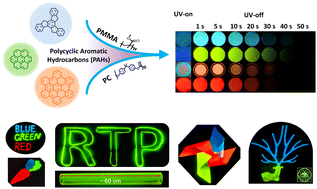A processable, scalable, and stable full-color ultralong afterglow system based on heteroatom-free hydrocarbon doped polymers†
Abstract
Although room-temperature phosphorescence (RTP) organic materials are a widely-studied topic especially popular in recent decades, long-lived RTP able to fulfil broad time-resolved application requirements reliably, are still rare. Polymeric materials doped with phosphorescent chromophores generally feature high productivity and diverse applications, compared with their crystalline counterparts. This study proves that pure polycyclic aromatic hydrocarbons (PAHs) may even outperform chromophores containing hetero- or heavy-atoms. Full-color (blue, green, orange and red) polymer–PAHs with lifetimes >5000 ms under ambient conditions are constructed, which provide impressive values compared to the widely reported polymer-based RTP materials in the respective color regions. The polymer–PAHs could be fabricated on a large-scale using various methods (solution, melt and in situ polymerization), be processed into diverse forms (writing ink, fibers, films, and complex 3D architectures), and be used in a range of applications (anti-counterfeiting, information storage, and oxygen sensors). Plus their environmental (aqueous) stability makes the polymer–PAHs a promising option to expand the portfolio of organic RTPs.



 Please wait while we load your content...
Please wait while we load your content...